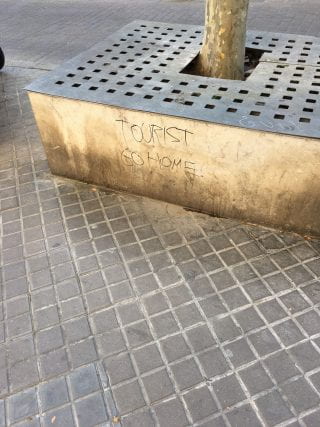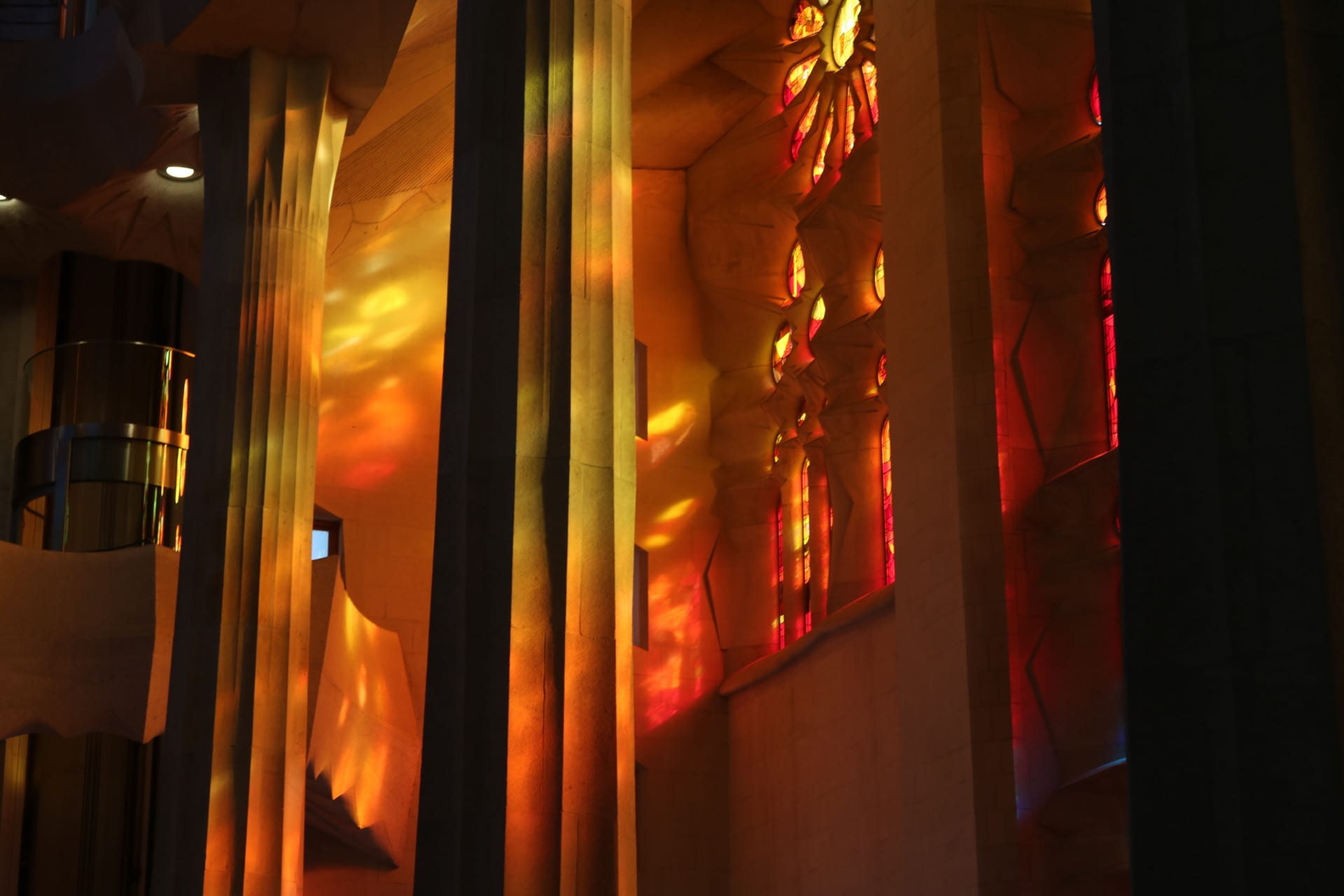
One of the many signs protesting the negative aspects of tourism that Maeve encountered during her semester in Spain.
International studies/Latin American studies major Maeve Mitchell spent her spring semester abroad in Barcelona, Spain. One day, as she was hurrying along the chilly winter streets, she had the sudden realization that at some point she had become a local. The impetus behind this realization was an encounter with a tourist group — Maeve knew about Barcelona’s reputation as a tourist destination, but only after she became a resident of the city did she begin to contemplate the negative effects of tourism, which she outlines here.
“Spain is Different!”
I learned those words sitting in my Spanish History and Politics course. The slogan was coined by dictator Francisco Franco’s regime in the 1960s to bring tourists to the country, which was facing a massive economic depression. Franco’s administration marketed Spain as warm, full of beaches, rich in history and culture, and having incredible food and wine. The “Spain is Different” campaign worked — tourism became a booming industry in the Iberian nation and the economy was able to restructure and recover. Today the largest sector of the Spanish economy is tourism.
From the 1960s to today, Spain has changed drastically. In 1975, it began the transition from a dictatorship to a democracy. Later it hosted the 1992 Summer Olympics. The major cities such as Madrid, Valencia and Barcelona have grown into sprawling metropolises. The population has moved from largely homogenous to a mixture of peoples from around the world. I found myself in Barcelona this past semester. Even before I departed in early January, I knew Barcelona was a major tourist destination. Friends shared stories of spending a day in Barcelona before departing on a Mediterranean cruise or seeing the city on a tour of Spain. Barcelona is also one of the most popular locations to study abroad for college students globally. Within the first few days of my stay abroad, I understood the charm of the city. Even in the cold days of the new year, the streets were filled with people drinking and laughing under heaters. In every store, I was greeted with a warm “hola.” The trees leaned beautifully over the streets in an inviting arc. Each block had a vibrant and unique energy. I loved the city even through my jet-lagged haze.
As I became settled and began feeling more like a local, I saw the city differently. It still charmed me with its vibrance and joy; however, I began noticing selfie sticks and maps of the city in people’s hands. I heard languages that were neither Spanish nor Catalan. When shopping on Passeig de Gràcia or in Plaça Catalunya, I was bombarded with vendors selling bus tour tickets and cheap souvenirs. As I did every day, I walked past La Sagrada Familia, one of the most-visited Catholic churches in the world; however, one day it was different. As I was listening to my music and walking briskly through the cold morning, I ran into a large group of people taking selfies outside La Sagrada. I had to push past them in order to continue my walk to school. They were completely unbothered about being in the middle of the sidewalk blocking everyone. I muttered to myself, “I hate tourists.” What I said had two different meanings: first, that I felt myself to be a local, part of the city and community; secondly, that I saw tourists as annoyances who had no respect for the place they were in.
Tourism no doubt allows Barcelona to invest in growth, improvements, new technology and other important social services. The diversity of the city owes itself to the industry. But tourism does not foster authenticity or healthy perceptions of other nations, and it irks locals who are attempting to live their lives. Too often, “authentic” cultural experiences are created to lure tourists into believing they are not like other tourists and that they can become part of the place they are visiting. For example, many believe that Flamenco dancing is common across Spain, and especially in Barcelona. Flamenco is native to the Andalusia region in southern Spain and is not that popular outside of the region. This misconception commercializes a dance that has a long history and is part of the Andalusian culture, which then diminishes the identity of those who associate with the culture. Nearly everyone living in Barcelona, including myself, sees how tourism impacts the city. Some of the larger concerns with increased tourism include rising costs of living, commercialization of important traditions and money not spent on social programs. Some housing projects in Barcelona, especially in the La Mina neighborhood, are largely abandoned, and that money is used instead on maintaining beaches and popular tourist destinations, and funding marketing schemes for tourists.
 It pained me to see my new home as only a tourist destination. Visitors were immediately drawn to the beaches, Gaudi’s architecture and the many historical churches. They did not take the time to explore the smaller neighborhoods, enjoy food that was not paella, or mix with the warm residents. It was mid-February when I saw the first “Tourists Go Home” spray-painted on the sidewalk. From then on, almost weekly I would see that same sentiment painted on streets and on buildings. Speaking to Spaniards, I learned that they do not hate tourists; instead, they hate the ignorance tourists have toward their home. The majority of visitors do not know any Spanish or even attempt to learn basic conversation pieces. Some visitors have a reputation for their loud conversations and behaviors. Others do not respect the local traditions and expectations.
It pained me to see my new home as only a tourist destination. Visitors were immediately drawn to the beaches, Gaudi’s architecture and the many historical churches. They did not take the time to explore the smaller neighborhoods, enjoy food that was not paella, or mix with the warm residents. It was mid-February when I saw the first “Tourists Go Home” spray-painted on the sidewalk. From then on, almost weekly I would see that same sentiment painted on streets and on buildings. Speaking to Spaniards, I learned that they do not hate tourists; instead, they hate the ignorance tourists have toward their home. The majority of visitors do not know any Spanish or even attempt to learn basic conversation pieces. Some visitors have a reputation for their loud conversations and behaviors. Others do not respect the local traditions and expectations.
The months I lived in Barcelona, I barely visited common tourists spots and spoke (almost) perfect Spanish. I knew the “Tourists Go Home” graffiti did not apply to me. As I look back, I realize how unique my semester in Barcelona was — I had the chance to live there. For those who are passing through, taking it all in gradually is not always possible. That is why selfie sticks are raised into the sky and bus tours popular — it is a way for people to reflect on a new place over time, just in a different way than myself or other locals. In my future travels I hope I can blend in more and not be a burden to those who live there, by learning conversational language, getting to know the culture and minimizing my tourist footprint. As someone who lived through the experience, I know how meaningful it is when visitors respect locals and the city.

